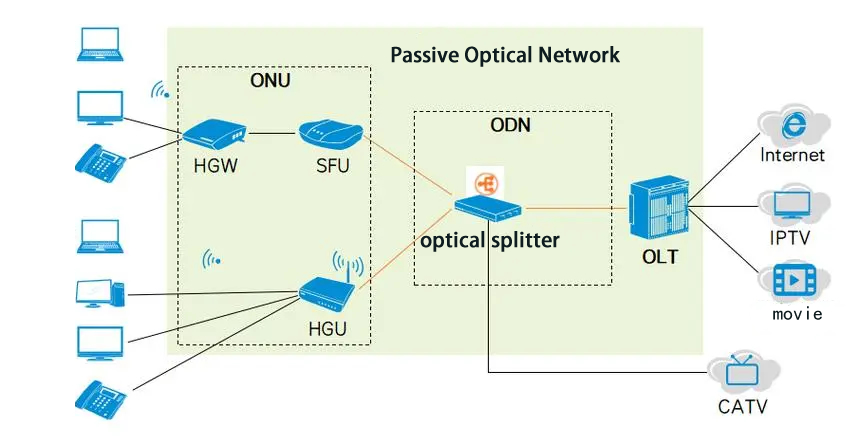1. Introduction to PON Network
PON (Passive Optical Network) is a fiber-optic access technology that establishes physical connections between users and network providers using passive devices such as optical splitters. The primary advantage of PON networks is their ability to provide high-bandwidth, low-latency connections while reducing the cost of network construction and maintenance.
2. Working Principle of PON Network
The working principle of a PON network is based on the transmission characteristics of optical fibers. In a PON network, data is transmitted in the form of light through optical fibers. Each user is connected to the network through an Optical Network Terminal (ONT), while the network provider provides services through an Optical Line Terminal (OLT).
3. Operating Process of PON Network
The operating process of a PON network can be divided into the following steps:
Data Transmission
In a PON network, data is transmitted in the form of light through optical fibers. This is achieved by converting electrical signals into optical signals, which occurs at both the user's ONT and the network provider's OLT.
Signal Distribution
In a PON network, a single OLT can serve multiple ONTs. This is achieved through the use of passive optical splitters. The splitter distributes the optical signals emitted by the OLT to multiple ONTs and also aggregates the optical signals emitted by multiple ONTs back to the OLT.
Error Detection and Correction
To ensure accurate data transmission, PON networks include error detection and correction mechanisms. These mechanisms can detect errors that occur during data transmission and attempt to correct them if found.

4. Technical Details of PON Network
Optical Network Terminal (ONT)
The ONT is a device located at the user's end. It converts optical signals into electrical signals so that the user's devices (such as computers, phones, and TVs) can use them. Conversely, the ONT also converts electrical signals from the user's devices into optical signals for transmission through the fiber optic cable.
Optical Line Terminal (OLT)
The OLT is a device located at the network provider's end, and its function is opposite to that of the ONT. It converts electrical signals from the network provider into optical signals for transmission through the fiber optic cable. Simultaneously, it converts optical signals received from the user's end back into electrical signals.
Passive Optical Splitter
The passive optical splitter is a crucial component in a PON network. It splits a single optical signal into multiple optical signals to serve multiple users. The splitter is "passive" because it operates without the need for a power source.

5. Factors Influencing PON Network Performance
The performance of a PON network is primarily determined by the following factors:
Bandwidth
Bandwidth is an essential metric for measuring network performance. In a PON network, bandwidth determines the amount of data that users can simultaneously send and receive.
Transmission Distance
Transmission distance refers to the maximum distance over which signals can be transmitted. In a PON network, the transmission distance depends on the quality of the optical fiber and the network design.
Split Ratio
The split ratio refers to the number of users that can be served by a single fiber optic line. In a PON network, the split ratio is determined by the design of the optical splitter and the network configuration.
In the evolution of PON technology, GPON and EPON have emerged as the new-generation broadband passive optical access standards, each exhibiting unique advantages.
GPON, based on the ITU-T G.984.x standard, offers high bandwidth, high efficiency, extensive coverage, and a rich user interface. By combining TDM and TDMA, it achieves flexible management of downstream and upstream links, providing users with a more robust network experience.
EPON, as an Ethernet-based PON technology, adopts a point-to-multipoint architecture, leveraging passive optical fiber transmission and utilizing Ethernet protocols at the data link layer. EPON combines the advantages of PON technology and Ethernet technology, offering traditional PON features such as low cost, high bandwidth, and scalability while maintaining compatibility with existing Ethernet and ease of management, making it a comprehensive and economical optical network solution.
Now, let's delve deeper into the specifics of GPON and EPON.


